The Self-Service BI Market is estimated to be valued at USD 13.1 billion in 2025 and is projected to reach USD 54.9 billion by 2035, registering a compound annual growth rate (CAGR) of 15.4% over the forecast period.
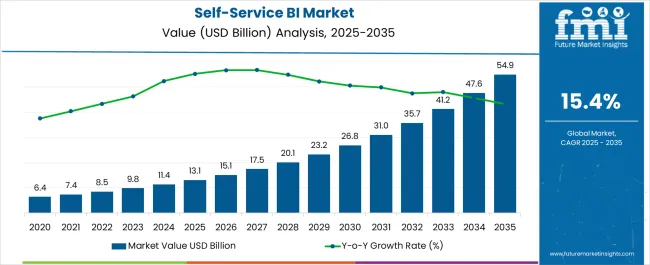
| Metric | Value |
|---|---|
| Self-Service BI Market Estimated Value in (2025 E) | USD 13.1 billion |
| Self-Service BI Market Forecast Value in (2035 F) | USD 54.9 billion |
| Forecast CAGR (2025 to 2035) | 15.4% |
The self service BI market is experiencing robust growth driven by the increasing demand for democratized data access, enabling non technical users to independently generate insights without relying heavily on IT teams. Organizations are increasingly prioritizing agility and faster decision making, prompting adoption of BI tools that offer intuitive interfaces, drag and drop capabilities, and seamless integration with diverse data sources.
The shift toward data driven cultures, supported by advancements in cloud based analytics, artificial intelligence, and embedded analytics, is further enhancing market traction. Regulatory compliance and data governance initiatives are also influencing adoption, as enterprises seek platforms that balance accessibility with security.
The market outlook remains strong as businesses across sectors continue to invest in solutions that empower employees to make informed decisions, reduce reporting bottlenecks, and accelerate operational performance.
The market is segmented by Type, Functional Areas, and Application and region. By Type, the market is divided into Tableau, Qlik, Splunk, SAS, Trillium, Logi Analytics, Crimson Hexagon, Apteryx, Tibco, Driven BI, and Others. In terms of Functional Areas, the market is classified into Marketing, Human Resources, Sales, Finance, and Operations. Based on Application, the market is segmented into Banking , Financial Services & Insurance, Government, Transportation & Logistics, Telecommunication & IT, Media & Entertainment, Healthcare, Manufacturing, and Others. Regionally, the market is classified into North America, Latin America, Western Europe, Eastern Europe, Balkan & Baltic Countries, Russia & Belarus, Central Asia, East Asia, South Asia & Pacific, and the Middle East & Africa.
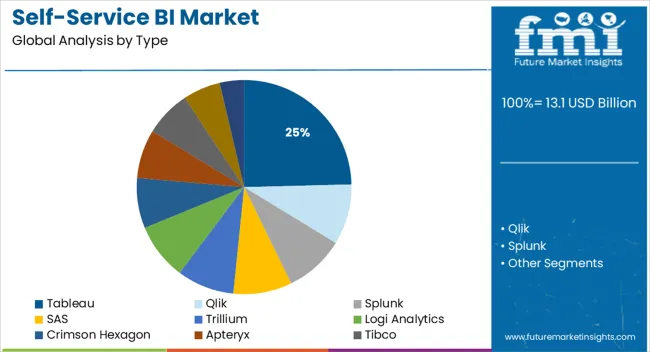
The Tableau segment is projected to hold 24.60% of total market revenue by 2025 within the type category, making it one of the most prominent platforms in the self service BI landscape. Its dominance is attributed to its powerful visualization capabilities, ease of use, and strong integration with a variety of data sources.
The platform’s drag and drop functionality, interactive dashboards, and robust community support have made it a preferred choice for organizations aiming to promote a data driven culture. Continuous feature enhancements and compatibility with both on premise and cloud environments have reinforced its widespread adoption.
This blend of functionality, scalability, and user friendliness has solidified Tableau’s leading position within the type segment.
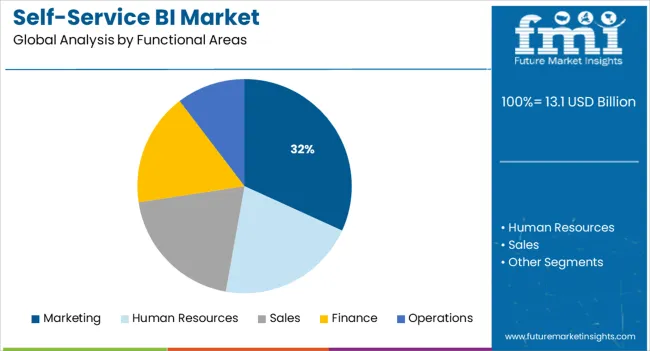
The marketing functional areas segment is expected to account for 31.80% of total market revenue by 2025, reflecting its status as the largest functional application of self service BI tools. This growth is fueled by the increasing reliance on data driven marketing strategies, real time campaign performance tracking, and audience segmentation.
Marketing teams are leveraging BI tools to gain actionable insights from customer behavior, optimize digital advertising spend, and measure return on investment with precision. The accessibility of these insights without IT intervention empowers marketing professionals to respond quickly to market dynamics, enhancing competitive positioning.
As personalization and omnichannel engagement become critical, marketing continues to be a major driver of self service BI adoption.
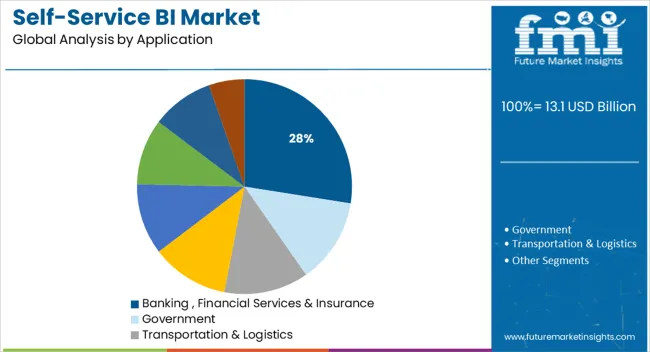
The banking financial services and insurance application segment is projected to capture 27.50% of total market revenue by 2025, making it a leading industry vertical for self service BI solutions. The sector’s demand is driven by the need for real time risk assessment, fraud detection, regulatory compliance, and customer analytics.
Self service BI enables BFSI institutions to consolidate large volumes of transactional and customer data into actionable insights without lengthy reporting cycles. Enhanced decision making in areas such as credit risk evaluation, investment strategies, and operational efficiency has been realized through these tools.
As data security and governance remain top priorities, BFSI organizations continue to invest in self service BI platforms that balance robust analytics capabilities with compliance requirements, ensuring sustained growth in this segment.
The growing requirement to develop inside and out competitive information inspection and the rising volume of company information are the primary drivers for the worldwide self-service BI market. Other factors that contribute to and accelerate market growth include continuously altering businesses, the need for an improved research-driven association, and the failure to meet customer expectations on time.
Additionally, the adoption of self-service BI systems to acquire insights without the requirement for a dedicated staff or technical supervision has blossomed as a result of the development in data-driven decision-making models among companies, which is thriving the analytics market.
Digitization has led to an increase in the volume of data produced by corporate processes. Using self-service BI solutions, businesses may combine and analyze data from numerous silos and real-time data into reports. Additionally, business developers or chief executives seek technologies that enable them to access an adaptive semantic model and act as data modelers.
Using self-service BI solutions, businesses may edit dashboards and reports. Additionally, they can help customers filter data or build reports based on their key performance metrics. These factors will likely cause the worldwide self-service BI market to grow over the projected period.
Large Initial Capital Need
One of the key factors influencing the global market is the sig nificant initial capital expenditure required to implement self-service BI systems. This is necessary in order to partially impede market growth. Another innovative aspect of the Self-Service BI Market is the expansion of self-service examination tools among small and medium-sized businesses (SMEs).
The volume of structured and unstructured data is increasing globally, which can be attributed to factors such as globalization, rising internet usage, increased use of social media platforms, and the booming e-commerce industry.
This is one of the major driving forces behind the adoption of service-service BI, especially considering the increased uptake of data analytics solutions by small and medium-sized organizations (SMEs).
Businesses can decentralize the process of business analysis with its help. Additionally, the market players are being given lucrative growth prospects by the growing adoption of cloud computing technologies in business intelligence. In addition, as governing bodies in many nations promote the use of digital payments, a significant increase in people switching to online payments has been observed.
Financial institutions like banks are therefore looking for technology solutions to increase the productivity of their current employees. This has a beneficial impact on how self-service BI is used globally, along with the increased demand for enterprises to be nimbler and maintain a competitive advantage in the market.
Owing to the need for modernizing business report analysis and modeling of data, a transition from complicated BI tools that only IT specialists could implement to self-service BI tools took place. Self-service BI market witnessed a prominent adoption across various business fields such as marketing, sales, operations, human resource and finance attributed to detailed competitive analysis and ease of application for non-technical staff.
Self-service BI benefits the business users from non-analytical background to generate insights and data analysis. Self-service BI market is experiencing an increasing demand for the business fields attributed to its ability to transform business organizations into an efficient data-driven organization. Self-service BI market is projected to grow over the forecast period owing to its ability to decentralize the business analytical process.
Self-service BI market serves as a boon to the non-technical business users for analyzing data insights by funneling down the business data. The self-service BI market is briskly growing owing the shift from conventional BI tools for business data analysis to modern BI tools along with the surging market of structured and unstructured data.
The primary drivers for global self-service BI market are the growing demand for generating in-depth competitive data analysis and expanding the business data volume. Other factors that boost up the growth of global self-service BI market include persistent changing business needs, the need for being an improved analytic-driven organization and IT’s inability to meet the business requests within the stipulated time.
Self-service BI market witnesses an increasing demand owing to its attributes over traditional BI tools. Features such as user-friendly, interactive ability to access or extend both IT related data and non-traditional data give the self-service BI market a competitive edge thereby increasing its demand in the business enterprises.
Self -service BI market growth is attributed to the increasing demand for various business functions including marketing, sales, operations, human resource, and finance. Human resource accounts for a significant demand for the self-service BI market due to the need to understand the competencies, workforce data, compensation structure and others factors that contribute in maximizing the return on human capital investment.
Besides, human resource, financial services also contribute to the increasing demand for global self-service BI market owing to the growing demand for financial transactions.
However, deploying self-service BI tools demand an effective and detailed data governance, integrated monitoring and controlling user interactions which are the critical challenges that are expected to hinder the growth of self-service BI market.
Another major restraint that is expected to deter the growth of self-service BI market is the challenge to deliver a single and unified insight of the enterprise data and having the correct data foundation.
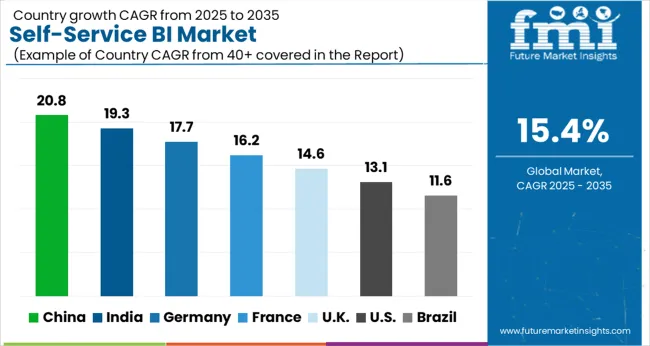
The regional coverage for self-service BI market includes North America, Latin America, Western Europe, Eastern Europe, Asia Pacific excluding Japan (APEJ), Japan and Middle East and Africa (MEA). North America accounts for a dominant share in the global self-service BI market attributed to early and increasing application of self-service BI tools and rapid technological advancement.
APEJ poses potential opportunities for self-service BI market to expand across industry verticals.
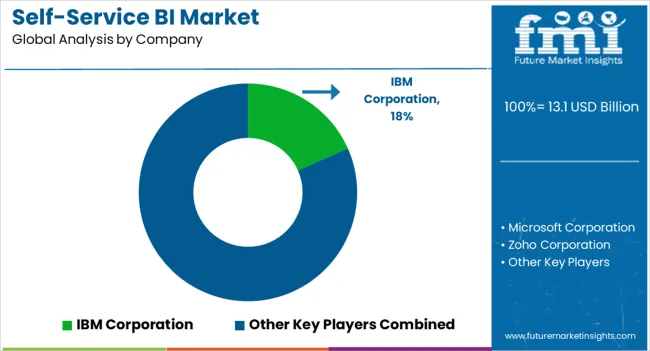
Key players in the global self-service BI market include IBM Corporation, Microsoft Corporation, Zoho Corporation, Dataphine, Qlik Technologies, Tableau Software, SAP SE, Tibco Software, Looker and others.
The global self-service bi market is estimated to be valued at USD 13.1 billion in 2025.
The market size for the self-service bi market is projected to reach USD 54.9 billion by 2035.
The self-service bi market is expected to grow at a 15.4% CAGR between 2025 and 2035.
The key product types in self-service bi market are tableau, qlik, splunk, sas, trillium, logi analytics, crimson hexagon, apteryx, tibco, driven bi and others.
In terms of functional areas, marketing segment to command 31.8% share in the self-service bi market in 2025.
x






Our Research Products

The "Full Research Suite" delivers actionable market intel, deep dives on markets or technologies, so clients act faster, cut risk, and unlock growth.

The Leaderboard benchmarks and ranks top vendors, classifying them as Established Leaders, Leading Challengers, or Disruptors & Challengers.

Locates where complements amplify value and substitutes erode it, forecasting net impact by horizon

We deliver granular, decision-grade intel: market sizing, 5-year forecasts, pricing, adoption, usage, revenue, and operational KPIs—plus competitor tracking, regulation, and value chains—across 60 countries broadly.

Spot the shifts before they hit your P&L. We track inflection points, adoption curves, pricing moves, and ecosystem plays to show where demand is heading, why it is changing, and what to do next across high-growth markets and disruptive tech

Real-time reads of user behavior. We track shifting priorities, perceptions of today’s and next-gen services, and provider experience, then pace how fast tech moves from trial to adoption, blending buyer, consumer, and channel inputs with social signals (#WhySwitch, #UX).

Partner with our analyst team to build a custom report designed around your business priorities. From analysing market trends to assessing competitors or crafting bespoke datasets, we tailor insights to your needs.
Supplier Intelligence
Discovery & Profiling
Capacity & Footprint
Performance & Risk
Compliance & Governance
Commercial Readiness
Who Supplies Whom
Scorecards & Shortlists
Playbooks & Docs
Category Intelligence
Definition & Scope
Demand & Use Cases
Cost Drivers
Market Structure
Supply Chain Map
Trade & Policy
Operating Norms
Deliverables
Buyer Intelligence
Account Basics
Spend & Scope
Procurement Model
Vendor Requirements
Terms & Policies
Entry Strategy
Pain Points & Triggers
Outputs
Pricing Analysis
Benchmarks
Trends
Should-Cost
Indexation
Landed Cost
Commercial Terms
Deliverables
Brand Analysis
Positioning & Value Prop
Share & Presence
Customer Evidence
Go-to-Market
Digital & Reputation
Compliance & Trust
KPIs & Gaps
Outputs
Full Research Suite comprises of:
Market outlook & trends analysis
Interviews & case studies
Strategic recommendations
Vendor profiles & capabilities analysis
5-year forecasts
8 regions and 60+ country-level data splits
Market segment data splits
12 months of continuous data updates
DELIVERED AS:
PDF EXCEL ONLINE
Bio-Fiber Tether Packs Market Analysis - Size and Share Forecast Outlook 2025 to 2035
Biobased Binder for Nonwoven Market Size and Share Forecast Outlook 2025 to 2035
Bio-Based Binder for Building Materials Market Size and Share Forecast Outlook 2025 to 2035
Biodegradable Microencapsulation Technology Market Size and Share Forecast Outlook 2025 to 2035
Bismuth Yellow Market Size and Share Forecast Outlook 2025 to 2035
Biodegradable Film Market Size and Share Forecast Outlook 2025 to 2035
Biodegradable Disposable Tableware Market Size and Share Forecast Outlook 2025 to 2035
Bipolar Electrodialysis Membrane Market Size and Share Forecast Outlook 2025 to 2035
Bio-based Cutlery Market Size and Share Forecast Outlook 2025 to 2035
Bird Cages & Accessories Market Size and Share Forecast Outlook 2025 to 2035
Bio-wax Market Size and Share Forecast Outlook 2025 to 2035
Biomass Hot Air Generator Furnace Market Size and Share Forecast Outlook 2025 to 2035
Biological Indicator Vial Market Size and Share Forecast Outlook 2025 to 2035
Bitumen Modifier Industry Analysis in Europe Size and Share Forecast Outlook 2025 to 2035
Bioplastic and Biopolymer Market Forecast Outlook 2025 to 2035
Biodegradable Paper and Plastic Packaging Market Size and Share Forecast Outlook 2025 to 2035
Biocatalysis and Biocatalyst Market Size and Share Forecast Outlook 2025 to 2035
Biodegradable Polyester Fiber Market Forecast and Outlook 2025 to 2035
Biopsy Device Market Forecast and Outlook 2025 to 2035
Bioliquid Heat and Power Generation Market Size and Share Forecast Outlook 2025 to 2035

Thank you!
You will receive an email from our Business Development Manager. Please be sure to check your SPAM/JUNK folder too.
Chat With
MaRIA